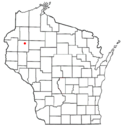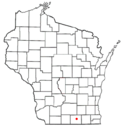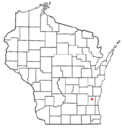University of Wisconsin System facts for kids
 |
|
|
Other names
|
UW System Universities of Wisconsin |
|---|---|
| Type | Public university system |
| Established | 1848 |
| Endowment | $738.5 million (2021) |
| Budget | $7.53 billion (2023–24) |
| President | Jay Rothman |
| Students | 160,782 |
| Undergraduates | 135,263 |
| Postgraduates | 25,519 |
| Location |
,
,
United States
|
| Campus |
|
| Colors | (Navy blue and teal) |
 |
|
The University of Wisconsin System is a big group of public universities in Wisconsin, USA. It is one of the largest public higher education systems in the country. Each year, over 160,000 students attend these universities. About 41,000 teachers and staff work across the state. The main office for the system is in Madison, the state capital.
The UW System includes two large research universities where students can earn advanced degrees. It also has eleven other universities and eight smaller branch campuses. In 2023, Wisconsin was ranked 4th in the nation for funding its two-year colleges.
Contents
History of the UW System
The University of Wisconsin System we know today was created on October 11, 1971. This happened when two separate university groups joined together. These were the old University of Wisconsin and the Wisconsin State Universities systems. The official merger took place on July 9, 1974.
The Original University of Wisconsin
The first University of Wisconsin was started by the state in 1848. Its first classes were held in Madison in 1849.
In 1956, more people wanted to go to college in Milwaukee, Wisconsin's biggest city. So, lawmakers combined two schools there. These were the Wisconsin State College of Milwaukee and a part of the University of Wisconsin. They formed the University of Wisconsin–Milwaukee.
Starting in the 1940s, smaller centers opened across the state. These centers offered classes for first and second-year college students. By 1968, some of these centers grew into full four-year universities. For example, the Green Bay center became the University of Wisconsin–Green Bay. The Kenosha and Racine centers joined to become the University of Wisconsin–Parkside.
By 1971, the University of Wisconsin system had campuses in Madison, Milwaukee, Green Bay, and Kenosha/Somers. It also had 10 two-year centers. About 69,554 students were enrolled at that time.
The Wisconsin State Universities
In 1866, the state started a "normal school" in Platteville. Normal schools were places to train teachers. This was the first of eight such schools across Wisconsin.
Later, in 1911, these normal schools were allowed to offer more than just teacher training. They added classes in art, science, and other subjects. This made them very popular.
In 1926, the normal schools became "State Teachers Colleges." They offered four-year programs to earn a Bachelor of Education degree. After World War II, many veterans needed more college options. So, these colleges were allowed to offer degrees in other subjects too.
In 1951, the State Teachers Colleges were renamed "Wisconsin State Colleges." They offered a full range of college subjects. In 1964, these state colleges were all given university status. They became the "Wisconsin State Universities."
By 1971, the Wisconsin State Universities included nine public universities. These were in Platteville, Whitewater, Oshkosh, River Falls, Stout (Menomonie), Superior, Stevens Point, La Crosse, and Eau Claire. They also had four two-year branch campuses. About 64,148 students were enrolled in this system.
The Merger of Systems
The University of Wisconsin system and the Wisconsin State University system joined in 1971. This created the University of Wisconsin System we have today. The new system had 13 universities and 14 two-year centers. It also had a statewide extension program.
Each university was named "University of Wisconsin–" followed by its location. For example, University of Wisconsin–Madison. Some people worried that having so many schools share the "University of Wisconsin" name might make it less special.
Today, the Board of the University of Wisconsin System has 18 members. Most are chosen by the Governor and approved by the Senate. Two members are current UW System students.
Changes in 2018
In October 2017, the president of the UW System, Ray Cross, suggested a big change. He proposed that the two-year UW Colleges should be managed by the closest four-year university. This would create regional two-year campuses.
This plan was approved in November 2017. It started to be put into action on July 1, 2018. The goal was to save money and make the system work better.
Campus Closures Since 2023
Since 2023, some of the University of Wisconsin branch campuses have closed. For example, University of Wisconsin–Platteville Richland closed in 2023. This was the first UW campus to close since 1980.
After this, four more UW branch campuses have closed. One campus now offers all its classes online. Another has stopped using several of its buildings. These changes have led to discussions about the future of the "Wisconsin Idea." The Wisconsin Idea is a belief that the university should serve all people of the state.
Campuses
Main Campuses
| Campus | Founded | Enrollment (Fall 2023) |
Endowment (2021–22) (millions) |
Athletic affiliation | Athletic nickname (Conference) |
U.S. News Rank (Midwest 2024) |
Carnegie Classification |
|---|---|---|---|---|---|---|---|

|
1848 | 50,335 | 4,000.0 | NCAA D-I (FBS) |
Badgers (Big Ten) |
35 (national) | R1: Doctoral Universities Very high research activity |

|
1956 | 22,703 | 262.0 | NCAA D-I (non-football) |
Panthers (Horizon) |
332 (national) | R1: Doctoral Universities Very high research activity |

Oshkosh |
1871 | 13,778 | 22.0 | NCAA D-III | Titans (WIAC) |
332 (national) | Doctoral Universities Doctoral/Professional Universities |

Whitewater |
1868 | 11,522 | NCAA D-III | Warhawks (WIAC) |
43 | Master's Universities Larger Programs |
|

La Crosse |
1909 | 10,275 | 45.9 | NCAA D-III | Eagles (WIAC) |
249 (national) | Master's Universities Larger Programs |

Eau Claire |
1916 | 9,949 | 80.5 | NCAA D-III | Blugolds (WIAC) |
21 | Master's Universities Medium Programs |

|
1965 | 10,338 | NCAA D-I (non-football) |
Phoenix (Horizon) |
60 | Master's Universities Medium Programs |
|

Stevens Point |
1894 | 8,184 | NCAA D-III | Pointers (WIAC) |
47 | Master's Universities Medium Programs |
|

Stout |
1891 | 6,938 | 64.5 | NCAA D-III | Blue Devils (WIAC) |
67 | Master's Universities Larger Programs |

Platteville |
1866 | 6,700 | NCAA D-III | Pioneers (WIAC) |
67 | Master's Universities Larger Programs |
|

River Falls |
1874 | 5,058 | NCAA D-III | Falcons (WIAC) |
60 | Master's Universities Medium Programs |
|

Parkside |
1968 | 4,030 | 5.6 | NCAA D-II | Rangers (GLIAC) |
103 | Master's Universities Medium Programs |

Superior |
1893 | 2,721 | NCAA D-III | Yellowjackets (UMAC) |
124 | Master's Universities Medium Programs |
Branch Campuses
Current Branch Campuses
| Campus | Parent campus |
Founded | Enrollment (Fall 2022) |
Athletic nickname (Conference) |
|---|---|---|---|---|

Barron County |
Eau Claire | 1966 | 455 | Blugolds |

Manitowoc |
Green Bay | 1933 | 373 | Blue Devils |

Sheboygan |
Green Bay | 1933 | 440 | Wombats |

Baraboo Sauk County |
Platteville | 1968 | 179 | Fighting Spirits (WCC) |

Wausau |
Stevens Point | 1933 | 404 | Huskies (WCC) |

Marshfield |
Stevens Point | 1963 | 344 | Marauders (WCC) |

Rock County |
Whitewater | 1966 | 593 | Rattlers |
Former Branch Campuses
| Campus | Parent campus |
Founded | Closed | Final enrollment |
Nickname |
|---|---|---|---|---|---|

Fox Cities |
Oshkosh | 1933 | 2025 | Cyclones (WCC) |
|

Marinette |
Green Bay | 1935 | 2025 | Buccaneers | |

Waukesha |
Milwaukee | 1966 | 2025 | Panthers | |

Richland |
Platteville | 1967 | 2023 | 60 | Roadrunners |

Fond du Lac |
Oshkosh | 1968 | 2024 | 258 | Falcons (WCC) |

Washington County |
Milwaukee | 1968 | 2024 | Wildcats | |

Medford |
Stevens Point | 1968 | 1980 | 90 | (WCC) |
University Branding
Since the universities and colleges joined in 1971, there has been some discussion about the name. The name "University of Wisconsin" is often used to mean just the Madison campus. This has made it harder for other UW schools to become well-known on their own.
On the other hand, some people connected to UW–Madison felt that sharing the "University of Wisconsin" name with so many schools made their own name less special.
In 2006 and 2009, students at UW–Milwaukee voted on changing their school's name. They wondered if it should be something like "University of Milwaukee." Most students voted to keep the "University of Wisconsin–Milwaukee" name. However, more than half of them were open to a different name.
Since 2004, the UW–Milwaukee sports teams have simply been called the Milwaukee Panthers. UW–Green Bay did the same and are now the Green Bay Phoenix. Many other UW System sports teams are often called by just their city name. This is because they play in the same sports conference, the Wisconsin Intercollegiate Athletic Conference (WIAC).
In October 2023, the system president, Jay Rothman, announced a new look for the system. It would be called "Universities of Wisconsin." It also got a new logo and colors. The official legal name of the system, however, stayed the same.
See also
 In Spanish: Sistema Universitario de Wisconsin para niños
In Spanish: Sistema Universitario de Wisconsin para niños
- List of state and territorial universities in the United States
- University of Wisconsin Credit Union
- Wisconsin Technical College System

